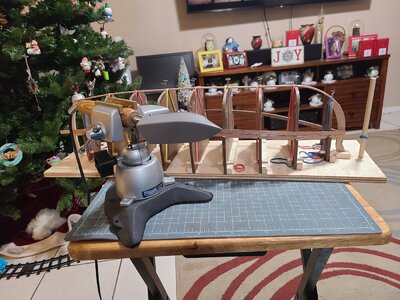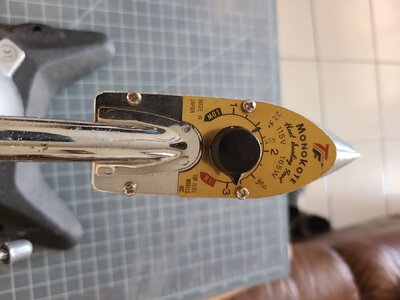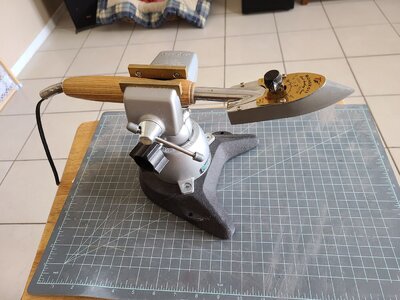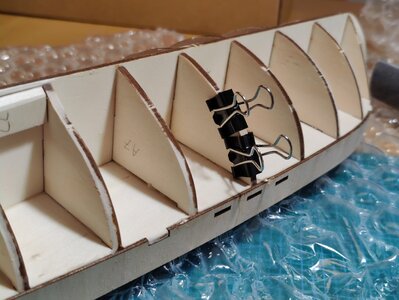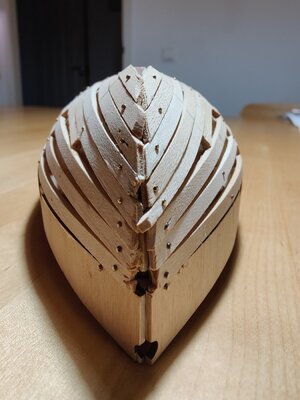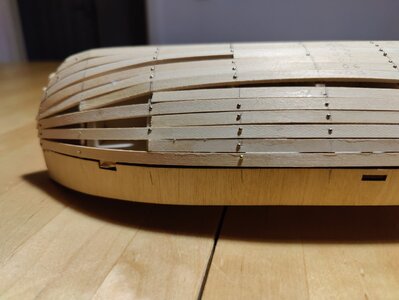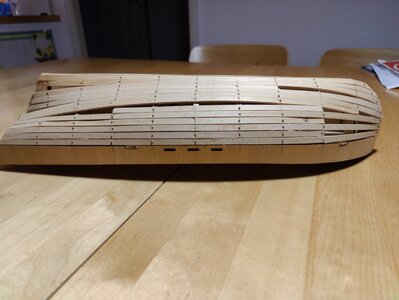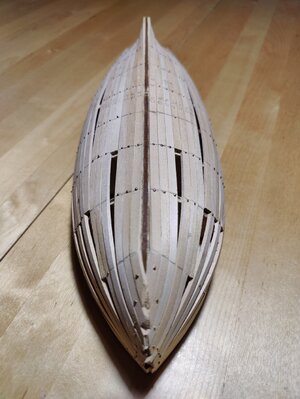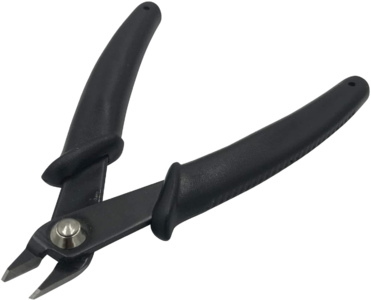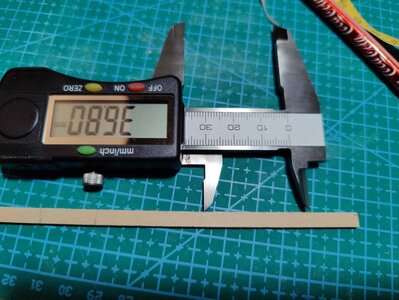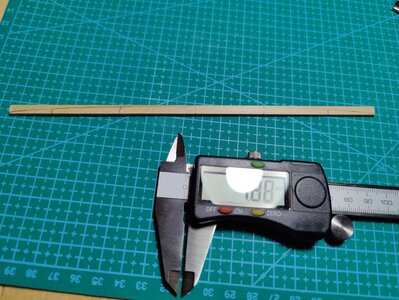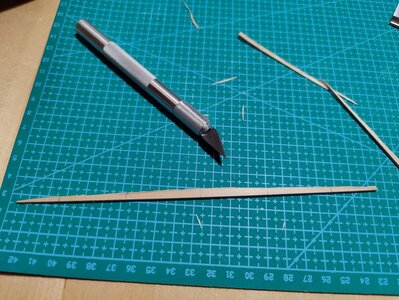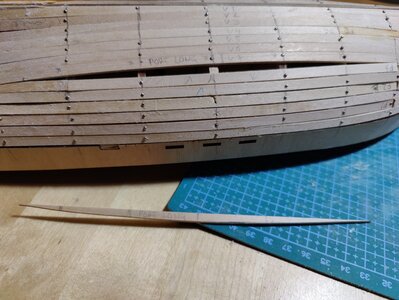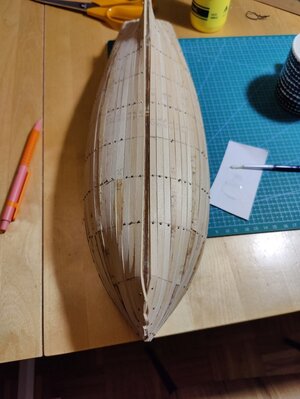This is the build log of my first ever wooden ship model, the OcCre Polaris Schooner.
Since the project is on the way, I won´t flood you with all the pictures I´ve taken during the process.
It has been a huge learning experience and every step has been like a project of its own. I´ve made mistakes in every step, but they have also been very valuable learnings in their own.
Here is a brief history:
The process began with attaching the bulkheads to the false keel, which was pretty straightforward task. I made sure that the ribs are aligned in 90 degree angle relative to the keel, but during the process one of the bulkheads had tilted a very slightly to starboard side. Perhaps attaching a counter weight could help if I encounter a similar situation in the future. Need to pay more attention to this kind of a situation in the future.
Next was the planking of the deck. I prepared the caulking with a soft lead pencil and glued the strips to the deck with a contact glue recommended by the friendly gentlemen from a hobby store. I glued the strips as a whole instead of cutting them into appropriate length strips. Just to make things a little bit easier. Again, I messed up! Despite my best efforts, I did not manage to draw a straight line through the deck. Maybe it was because I had to measure one of the horizontal ”check points” across the deck twice and then drew the line across a wrong point. I also need a longer ruler to make the line in one stroke. It´s a cosmetic thing but still an annoying mistake. I need to be more precise in the future. The results of caulking were should I say variable. In some parts it looks good, in some its not visible, and in some its outright terrible. I also need practice in marking the nails on the deck.
Then I added the wooden parts on the bow and on the stern. I don´t know what they are officially called, but as you likely know already I mean the parts that provide an extra base for the planks so they can be attached more securely. Sanding the bow parts was quite a laborious task but the end result was in my opinion very nice. Sanding the bow, bulkheads and the stern ”blocks” took a long time. I wanted to do it as well as possible so that I have a good base to start adding the planks to the frame. I also sanded the stern of the false keel a bit thinner. Perhaps now I don´t have to sand the planks on the stern side so much after the planking is done.
The current state of the project is that I have installed the bulwarks. I added the one on the starboard side first. I soaked the wood for about 15 minutes in warm water and started gently bending it to a proper shape. Once I felt that it looked good enough after dry fitting, I did some extra bending with Artesania Latina´s electric plank bender, which should be called a plank burner instead! Then I added carpenters glue to the middle section of the deck and secured the bulwark on the deck with cheap clamps I found from a local supermarket. Those really saved the day and so did Amati´s Keel Klamper tool in which I had attached the frame! It proofed its worth in this case! Next was the bow section. I used glue and a small nail just in case. The last came the stern section with a similar approach to the bow section. I also used a clamp for extra hold.
With the port side bulwark the approach was the same, however a little bit easier now that I had some experience under my belt. Finally I added the plank in the stern in between the bulwarks.
Next comes the dreaded planking! I am more than a bit concerned with using the electric plank bender/burner for this. Should I get a plank nipper or use my wife´s curling iron? Any insights and suggestions are extremely welcome!
This is how the project looks like at the moment. Burn marks clearly visible!
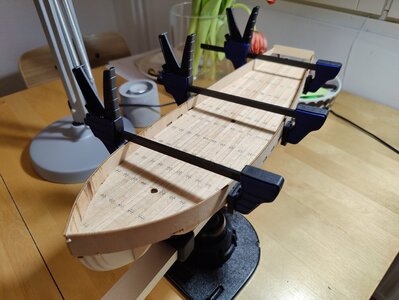
Since the project is on the way, I won´t flood you with all the pictures I´ve taken during the process.
It has been a huge learning experience and every step has been like a project of its own. I´ve made mistakes in every step, but they have also been very valuable learnings in their own.
Here is a brief history:
The process began with attaching the bulkheads to the false keel, which was pretty straightforward task. I made sure that the ribs are aligned in 90 degree angle relative to the keel, but during the process one of the bulkheads had tilted a very slightly to starboard side. Perhaps attaching a counter weight could help if I encounter a similar situation in the future. Need to pay more attention to this kind of a situation in the future.
Next was the planking of the deck. I prepared the caulking with a soft lead pencil and glued the strips to the deck with a contact glue recommended by the friendly gentlemen from a hobby store. I glued the strips as a whole instead of cutting them into appropriate length strips. Just to make things a little bit easier. Again, I messed up! Despite my best efforts, I did not manage to draw a straight line through the deck. Maybe it was because I had to measure one of the horizontal ”check points” across the deck twice and then drew the line across a wrong point. I also need a longer ruler to make the line in one stroke. It´s a cosmetic thing but still an annoying mistake. I need to be more precise in the future. The results of caulking were should I say variable. In some parts it looks good, in some its not visible, and in some its outright terrible. I also need practice in marking the nails on the deck.
Then I added the wooden parts on the bow and on the stern. I don´t know what they are officially called, but as you likely know already I mean the parts that provide an extra base for the planks so they can be attached more securely. Sanding the bow parts was quite a laborious task but the end result was in my opinion very nice. Sanding the bow, bulkheads and the stern ”blocks” took a long time. I wanted to do it as well as possible so that I have a good base to start adding the planks to the frame. I also sanded the stern of the false keel a bit thinner. Perhaps now I don´t have to sand the planks on the stern side so much after the planking is done.
The current state of the project is that I have installed the bulwarks. I added the one on the starboard side first. I soaked the wood for about 15 minutes in warm water and started gently bending it to a proper shape. Once I felt that it looked good enough after dry fitting, I did some extra bending with Artesania Latina´s electric plank bender, which should be called a plank burner instead! Then I added carpenters glue to the middle section of the deck and secured the bulwark on the deck with cheap clamps I found from a local supermarket. Those really saved the day and so did Amati´s Keel Klamper tool in which I had attached the frame! It proofed its worth in this case! Next was the bow section. I used glue and a small nail just in case. The last came the stern section with a similar approach to the bow section. I also used a clamp for extra hold.
With the port side bulwark the approach was the same, however a little bit easier now that I had some experience under my belt. Finally I added the plank in the stern in between the bulwarks.
Next comes the dreaded planking! I am more than a bit concerned with using the electric plank bender/burner for this. Should I get a plank nipper or use my wife´s curling iron? Any insights and suggestions are extremely welcome!
This is how the project looks like at the moment. Burn marks clearly visible!




